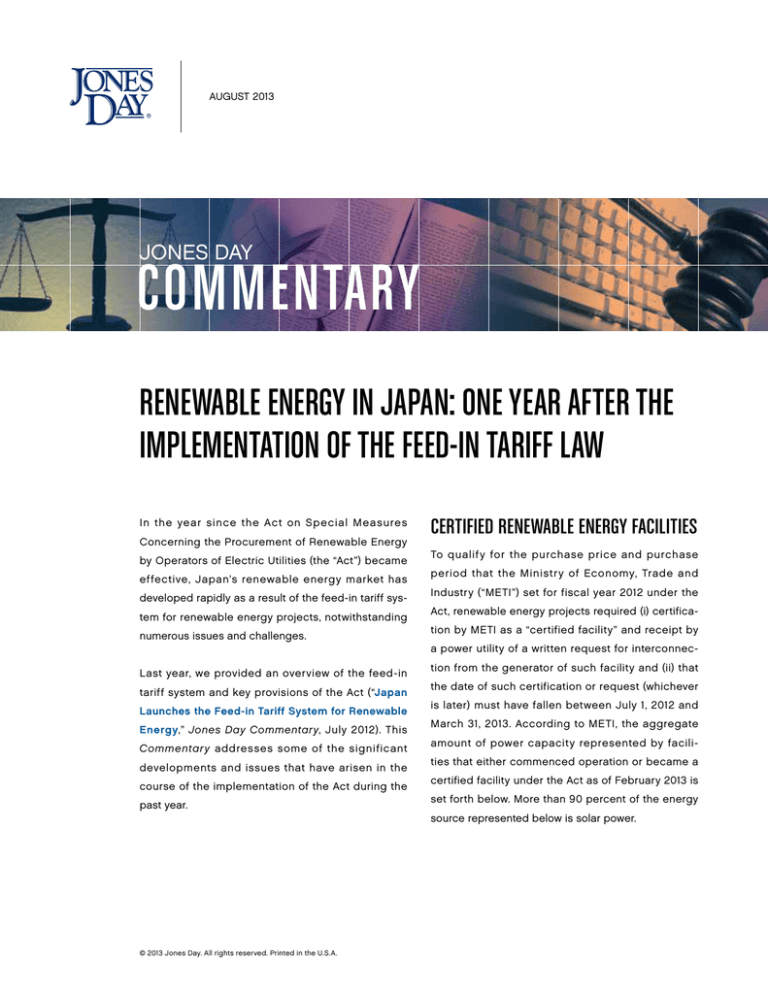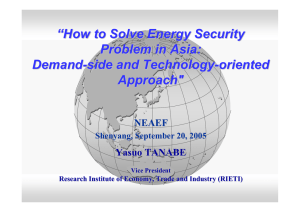
August 2013
JONES DAY
COMMENTARY
Renewable Energy in Japan: One Year After the
Implementation of the Feed-in Tariff Law
In the year since the Act on Special Measures
Concerning the Procurement of Renewable Energy
by Operators of Electric Utilities (the “Act”) became
effective, Japan’s renewable energy market has
developed rapidly as a result of the feed-in tariff system for renewable energy projects, notwithstanding
numerous issues and challenges.
Certified Renewable Energy Facilities
To qualif y for the purchase price and purchase
period that the Ministry of Economy, Trade and
Industry (“METI”) set for fiscal year 2012 under the
Act, renewable energy projects required (i) certification by METI as a “certified facility” and receipt by
a power utility of a written request for interconnec-
Last year, we provided an overview of the feed-in
tariff system and key provisions of the Act (“Japan
Launches the Feed-in Tariff System for Renewable
Energy,” Jones Day Commentary, July 2012). This
Commentary addresses some of the significant
developments and issues that have arisen in the
course of the implementation of the Act during the
past year.
tion from the generator of such facility and (ii) that
the date of such certification or request (whichever
is later) must have fallen between July 1, 2012 and
March 31, 2013. According to METI, the aggregate
amount of power capacity represented by facilities that either commenced operation or became a
certified facility under the Act as of February 2013 is
set forth below. More than 90 percent of the energy
source represented below is solar power.
© 2013 Jones Day. All rights reserved. Printed in the U.S.A.
Aggregate capacity of facilities
that became a certified facility
by February 2013
Aggregate capacity of facilities
that commenced operation
during the period from
April 2012 to February 2013
Solar (residential)
1,137,000 kW
1,246,000 kW
Solar (nonresidential)
422,000 kW
11,012,000 kW
Wind
63,000 kW
622,000 kW
Small or Mid-Sized Hydro
(1,000 kW or more)
1,000 kW
23,000 kW
Small or Mid-Sized Hydro
(less than 1,000 kW)
2,000 kW
5,000 kW
Biomass
36,000 kW
147,000 kW
Geothermal
1,000 kW
4,000 kW
Total
1,662,000 kW
13,059,000 kW
(Source: METI)
Purchase Price and Purchase Period for Fiscal Year 2013
METI has now announced the following purchase price (tax inclusive) and purchase period for renewable energy projects that
satisfy the certification and interconnection request requirements for fiscal year 2013:
Power Source
Purchase Price
Purchase Period
Solar (10 kW or more)
37.8 Yen/kWh
20 years
Solar (less than 10 kW)
38 Yen/kWh
10 years
Wind (20 kW or more)
23.1 Yen/kWh
20 years
Wind (less than 20 kW)
57.75 Yen/kWh
20 years
Hydro (1,000kW–30,000kW)
25.2 Yen/kWh
20 years
Hydro (200kW–1,000kW)
30.45 Yen/kWh
20 years
Geothermal (15,000kW or more)
27.3 Yen/kWh
15 years
Geothermal (less than 15,000kW)
42 Yen/kWh
15 years
Biomass (methane)
40.95 Yen/kWh
20 years
Biomass (unused trees)
33.6 Yen/kWh
20 years
Biomass (other than unused trees)
25.2 Yen/kWh
20 years
Waste Construction Materials
13.65 Yen/kWh
20 years
General Waste
17.85 Yen/kWh
20 years
2
METI established the purchase price for fiscal year 2013 with
Since the release of the METI Model Agreement, utility com-
input from the committee established by METI pursuant to
panies and renewable energy power producers have raised
the Act for the assessment of the purchase price and other
a number of questions on the METI Model Agreement. In
factors. The purchase price for fiscal year 2013 applicable
June 2013, METI sought to address some of these questions
to solar projects with a capacity of 10kW or more is 37.8 Yen
with a commentary on the METI Model Agreement. The com-
(tax inclusive), as compared to 40 Yen for fiscal year 2012.
mentary provides, in part:
In setting the purchase price for fiscal 2013, METI received
public comments arguing that the purchase price for solar
• The renewable energy power producer must maintain the
projects should remain the same as that for fiscal year 2012.
METI facility certification throughout the contract term.
In response, METI noted that the purchase price for fiscal
Under the METI Model Agreement, the agreement ter-
year 2013 would be lowered to reflect the reduced costs of
minates if such certification is revoked or is no longer in
solar projects, including the prices of panels, power condi-
effect for any reason. METI notes that the provisions are
tioners, and cradles as well as workers’ wages, all of which
consistent with the facility certification condition prec-
have decreased compared to those that were in effect when
edent for the utility company to be required to intercon-
the purchase price for fiscal year 2012 was determined.
nect facilities under the Act. Thus, METI explains that if a
utility company procures electric power from a renewable
energy power producer that does not have METI facility
METI Model Power Purchase and
Interconnection Agreement
certification, the utility may not pass on any portion of the
purchase price paid to such renewable energy power producer to the utility’s customers.
Power utilities are required under the Act, if requested by
a generator, to enter into an agreement on the supply and
• Costs for interconnection construction work must be
purchase of power generated by a certified facility, unless
borne by the renewable energy power producer. METI
a statutory exemption applies. Unfortunately, the lack of
points out that under the Act, the utility company may
a standard power purchase agreement for renewable
deny interconnection if a renewable energy power pro-
energy that was generally acceptable to market partici-
ducer does not bear the costs and fees for interconnec-
pants, including providers of financing for renewable energy
tion work. Although METI recognizes the negotiability
projects, meant that each utility published its own form of
of this provision under the METI Model Agreement, as a
power purchase agreement, often with terms unduly favor-
practical matter it seems unlikely that a utility company
able to the utility and inconsistent with the requirements
would agree to delete this provision as it directly reflects
of the Act. To address this issue, in September 2012 METI
the provisions of the Act.
released a Model Contract Form for Specified Agreement/
Interconnection Agreement (the “METI Model Agreement”)
• The utility company must notify the renewable energy
to serve as a model power purchase and interconnec-
power producer and may request an extension of the
tion agreement. This model agreement assumes that (i) the
work period, without compensation, if the scheduled
power purchaser and interconnection provider are the same
completion date for interconnection construction work
utility company; (ii) the power generating facility is a certi-
is delayed due to an act of God or any other reason not
fied facility for either solar or wind power with a capacity of
attributable to the utility company. Such extensions often
more than 500kW; (iii) the parties will enter into the agree-
occur when the utility company is unable to obtain the
ment before construction of the certified facility; and (iv) the
consent from the affected landowner to the easement for
power generator expects to obtain financing for the project.
the transmission line, and such delay typically results in a
delay in start-up of operation for a year or more.
3
Curtailment of Power Output
• The renewable energy power producer must pay the
amount of the over-run if there is a cost over-run for the
The Act sets no limit on the total amount of power a power
interconnection work, unless (i) the over-run is attribut-
utility is required to purchase from a certified facility. Even
able to the utility company or (ii) reasonable grounds
before the Act’s implementation, concerns existed around
exist for the renewable energy power producer to refuse
the possibility of oversupply and the resulting burden on
to pay such amount. One example of what may constitute
a utility’s electricity grid. The Act permits a power utility to
such reasonable ground for refusal is a case where the
instruct a power generator to restrain output without com-
increased cost does not have a reasonable basis. METI
pensation under certain circumstances, including for a
notes, however, that the failure of the renewable energy
period of up to 30 days if the estimated supply of power
power producer to obtain consent from its lender(s) to
exceeds demand despite certain countermeasures taken
pay such amount does not constitute a reasonable
by the utility. In addition, if interconnection is reasonably
ground for refusal.
expected to exceed a utility’s transmission capacity or
receptive capacity, the Act permits the utility to refuse inter-
Delay in Commencement of Operation
connection subject to certain requirements.
As noted above, solar projects represented the vast bulk of
The issue of oversupply has been particularly acute in
renewable energy projects qualifying for the purchase price
Hokkaido, where the availability of land has attracted many
applicable to fiscal year 2012. Most of these projects (espe-
developers. In December 2012, METI ordered the regional
cially nonresidential solar) have been certified by METI but
utility, Hokkaido Electric Power Co., Inc. (“HEPCO”) to con-
have not yet commenced operation. Commentators suggest
sider ways to increase interconnection capacity as it
that one reason for such delay in operation is that a sharp
appeared likely that the interconnection capacity required
increase in demand for solar panels and power condition-
for facilities seeking certification and interconnection to
ers has resulted in delay in delivery. Others observe that
HEPCO’s grid (around 400,000 to 600,000 kW) was likely to
certain developers and brokers, with no intention of operat-
exceed actual capacity. In April 2013, METI announced the
ing a renewable energy facility, nevertheless obtained a METI
following measures relating to HEPCO:
facility license in order to lock in the high purchase price
applicable to fiscal year 2012, with a view to selling rights to
• Amendment of the Act to permit a power utility located
such facility to a third-party investor. In these cases, develop-
in an area that does not have sufficient interconnection
ers or brokers obtained METI facility certification using land
capacity to ask certified facilities to curtail power output
that was difficult to develop due to geological conditions or
without limitation or compensation, subject to the require-
regulatory requirements. Although the application for METI
ment that the utility disclose its forecast of the duration
certification requires the designation of a scheduled start-
and extent of any such curtailment. This amendment
up date, at present, delays in the commencement of opera-
applies only to HEPCO and solar power facilities expected
tion do not affect the validity of the facility certification and
to generate 500kW or more in the areas covered by
require no notice of change in the start-up date. METI is cur-
HEPCO after the aggregate capacity for such solar power
rently considering whether to change this practice and poten-
facilities exceeds 700,000 kW. The effective date of this
tially withdraw facility certifications where the facility does not
proposed amendment has not been announced.
commence operation within a year of the date of certification.
In addition, METI is also considering withdrawing facility certifications and effectively changing the applicable purchase
price for certified facilities if there is a change in the type or
supplier of panels or power conditioners that were specified
in the application for certification.
4
• Separately, HEPCO is already experiencing difficulty in
providing interconnection to certified facilities, especially
those with a capacity of 2,000kW or more. As of April 2013,
the aggregate interconnection requirement of such facilities reached 400,000kW, which is the maximum interconnection capacity of HEPCO. METI has therefore confirmed
Lawyer Contacts
For further information, please contact your principal Firm
representative or one of the lawyers listed below. General
email messages may be sent using our “Contact Us” form,
which can be found at www.jonesday.com.
that, under such circumstance, HEPCO may deny applications for interconnection pursuant to the Act. In the meantime, HEPCO is considering installing large-scale storage
batteries (with a capacity of approximately 60,000 kW) to
expand its interconnection capacity, and once installed,
Hirokazu Ina
Tokyo
+81.3.6800.1836
hina@jonesday.com
these storage batteries are expected to increase HEPCO’s
interconnection capacity by 10 percent.
Kaoru Umino
Tokyo
On April 2, 2013, the Cabinet of Prime Minister Shinzo Abe
endorsed the Electric System Reform Plan that is intended to
+81.3.6744.1616
kumino@jonesday.com
strengthen the transmission infrastructure and adjustment function for electricity supply and demand in Japan. Implementation
required an amendment to the Electricity Business Act that was
expected during the most recent session of the Diet, but it was
not adopted, thereby resulting in further delay in necessary
Naho Kaneko
Tokyo
+81.3.6744.1682
nkaneko@jonesday.com
reforms to the electricity system in Japan.
Conclusion
The Japanese renewable energy market has enjoyed substantial growth since the implementation of the Act, as
evidenced by the number of facilities certified by METI
and the aggregate amount of power generating capacity
represented by these facilities. At the same time, the relatively small number of facilities that actually commenced
operation underscores the challenges for renewable
energy projects even after the METI certification process is
completed. In consultation with market participants, METI
sought to address some of these issues and challenges,
but capacity limitation for interconnection remains an overriding issue in some areas. Addressing this challenge will
require action by METI and, ultimately, the implementation
of a coordinated and comprehensive reform program by
the Japanese Government.
Jones Day publications should not be construed as legal advice on any specific facts or circumstances. The contents are intended for general
information purposes only and may not be quoted or referred to in any other publication or proceeding without the prior written consent of the
Firm, to be given or withheld at our discretion. To request reprint permission for any of our publications, please use our “Contact Us” form, which
can be found on our web site at www.jonesday.com. The mailing of this publication is not intended to create, and receipt of it does not constitute,
an attorney-client relationship. The views set forth herein are the personal views of the authors and do not necessarily reflect those of the Firm.




